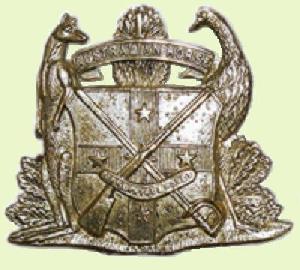Topic: Militia - LHN - 3/11/7
AH
Australian Horse
Birth of a Regiment, 1897
1st Australian Horse (Boer War) [1899 - 1901]
3rd (Australian Horse) Australian Light Horse [1903 - 1912]
11th (Australian Horse) Australian Light Horse [1912 - 1918]
7th (Australian Horse) Australian Light Horse [1919 - 1935]
7th/21st (Australian Horse) Australian Light Horse [1936-1937]
7th (Australian Horse) Australian Light Horse [1937 - 1942]
7th (Australian Horse) Australian Motor Regiment [1942 - 1943]
7th/21st (Australian Horse) Recce Regiment 1948 - 1937]
7th/21st Australian Horse [1949 - 1957]

Hearth and Home
Allied with: King Edward's Horse (The King's Overseas Dominions Regiment).
The following article about the Australian Horse and the Birth of a Regiment 1897 was written as Chapter 1 in the booklet produced by the Centenary Publications, Harden, August 1997 and produced by Clarion Editions at Binalong called, The Boys in Green - A Centenary History of the 1st Australian Horse and the Light Horse Units of Harden and Murrumburrah, New South Wales, and this extract is from pp. 3 - 4.
Chapter 1, Part 1
Birth of a Regiment, 1897
The right to wear a uniform of green was first bestowed on a British regiment of foot in 1800 when an elite formation of riflemen - the 95th Regiment - was formed to fight as skirmishers, similar to the German "jaegers" and French chasseurs (hunters). More lightly equipped than the slow-moving red-coated Regiments who were armed with muskets, the Riflemen marched at a brisker pace and carried the rifle, a weapon accurate at 400 metres (four times the range of a musket). The "greenjackets" had no colours - no richly embroidered king's and Regimental Colours to rally behind in battle; they were trained to fight in extended order to commands from bugle horn and whistle and to be the first into battle and the last to retire. At the end of the Napoleonic Wars their record was so outstanding that by order of the King the 95th were taken out of the Line and made a separate entity - The Rifle Brigade - an honour granted previously only to the King's household troops, the Brigade of Guards. From that date the green jacket, with its burnished buttons and black leather accoutrements, was more highly esteemed than the scarlet and gold of the Line infantry and was rapidly adopted throughout the Empire by many of the volunteer militia regiments, both mounted and foot, that sprang into being from the 1860s on, particularly by those whose men saw themselves as elite.
Not least among the attractions of the simple uniform of rifle green was the fact that it was relatively inexpensive - an important factor for militia officers who had to provide their own uniform and horses.
When the last British garrison regiment left Australia in 1870 the colonies began a belated programme of defence spending, their efforts intensified by the periodic "war scares" of the period - the possibility of war between Great Britain and Russia in 1884 was directly responsible for the purchase of gunboats galore by the colonies, and the raising of a militia regiment of cavalry at Parramatta in 1885, the now famous New South Wales Lancers. In the same year James Alexander Kenneth Mackay, an outstanding rider and the son of a grazier, formed a cavalry troop of volunteers from the men in the Camden district who provided their own horses and uniforms, The Mist Camden Light Horse. Mackay stood successfully for election for the Boorowa seat in 1895 as a Protectionist and in 1.891, when the volunteer component of the New South Wales Military Forces was being revived, set out to raise a regiment of cavalry in the rural areas of the Colony. The regiment would wear green uniforms and be known as the First Australian Horse. He chose to form its first troop in his electorate, at the twin towns of Harden and Murrumburrah.
Captain Mackay visited Harden-Murrumburrah on Saturday 28 August 1897 for the purpose of recruiting and enrolling members to start the 1st Australian Horse in the region. About 80 horsemen mustered on the local racecourse of which 60 were picked to form the local half squadron.
On Saturday 6 November 1897 the Harden-Murrumburrah Half Squadron of the 1st Australian Horse held a parade for final selection, all were passed by Lieutenant and Adjutant Thompson as fit for military purposes.
On 18 February 1898 the Adjutant, 1st Australian Horse, wrote from Headquarters in Sydney (9 Richmond Terrace, Outer Domain) to inform his officers of the following:
"A. In formulating his scheme for the formation of a distinctly Bush Force, Major Mackay aimed at utility - not show or unnecessary expense - but serviceable, inexpensive, and at the same time practical uniform suitable for the local conditions, and in keeping with the requirements of Officers located in Country districts.
"Perusal of the Dress Regulations and the original circular notifying the Governor's authority for the formation of the Australian Horse, will show that no gold or silver lace (always very expensive items in all other uniforms) is introduced in the Regimental Kit of our Bush Force.
"Bearing in mind the incidental expenses to which Officers are put in the way of providing and keeping a suitable charger for drills; loss of time from business in organizing and maintaining their respective units to full strength; annual attendances at camp, and being responsible for the drill, discipline, arms, uniform and Government property on issue to their men, the Major Commanding intends - of course subject to the approval of the General Commanding - to supply all Officers from the annual Capitation grant with Field Service uniform (hat, caps, jacket, pants, etc). Belts, sword, spurs, bridle, bit, stirrups, breastplate, headrope etc), to be issued as Regimental Property to Officers while serving in the regiment.
"Officers to supply themselves at present with a Full Dress Tunic, Gloves, and the necessary boots for parades (the men must also supply boots) and subsequently, when decided by the Officers as a whole, with a mess jacket and vest. The present uniform therefore should not be much above 10 guineas per uniform.
"B. The Major Commanding from his previous experience at Encampments, proposes to keep the expense of the Mess down to the lowest minimum cost; recognizing as he does that the days of junketting, when Officers assembled for Military training, are exploded in this utilitarian
period."
Some of the names that can be found from early records are:
1897 Nominal Roll - Harden and Murrumburrah
1. W. Affleck
2. F. Allsopp
3. T. Allsopp
4. G. Allsopp
5. R. Aiken
6. A. Barnes
7. T. Barnes
8. Sergeant Baxter
9. W. Black
10. A. Brown
11. J. Brown
12. Brown
13. Boreland
14. J. Bradford
15. Lieutenant J.K. Bourke
16. J. Callen
17. J. Chamberlain
18. E. Clarke
19. Cullen
20. P. Drum
21. Duke
22. J. Ellis
23. Edmonds
24. Farrier Sergeant R.S. Fallan
25. Flanery
26. Ford
27. J. Futter
28. Garland
29. W. Cannon
30. J. Gordon
31. H. Grant
32. Hayes
33. Hobson
34. Hodgson
35. L. Hunt
36. T. Hunt
37. Hutchinson
38. G.R. Irving
39. Kelly
40. Sergeant Kendall
41. Kinnar
42. G. Long
43. Martin
41. Corporal D. Macansh
45. Mitchell
46. A.L. Murphy
47. Sergeant O'Connell
48. Prest
49. Peterson
50. Dr. Parry, Medical Officer
51. J. Quinn
52. E. Reardon
53. T. Reid
54. T.R. Reid
55. CW. Russell
56. J. Rose
57. J. Shields
58. Bugler W. Simpson,
59. Smart
60. Spillane
61. Smith
62. Tout
63. Thompson
64. Watts, Sergeant
65. Wilson
66. J. Walsh
67. Whitty
Previous: 3rd/11th/7th Australian Light Horse
Next: Australian Horse, Training Begins, 1898 - The Boys in Green, Part 2
Further Reading:
3rd/11th/7th Australian Light Horse
Militia Light Horse, New South Wales
Australian Militia Light Horse
Citation: Australian Horse, Birth of a Regiment 1897 - The Boys in Green, Part 1



